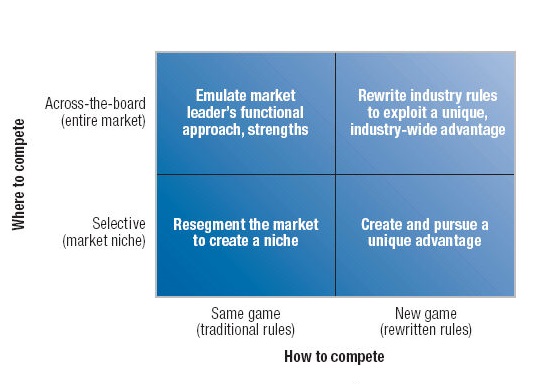The Strategic Game Board is a concept coined by McKinsey & Company, this strategic framework can be used to identify the strategic management options in a competitive landscape by showing the strategists that the business organization can choose where (market segments), how (business system) and when (timing) to compete.
A firm’s decisions pertaining to the scope and mode of competition and the time for the overall action should be based on a continuous analysis of the firm’s strengths, vulnerabilities, and resources in relation to those of its competitors. The strategic game board describes the options open to a firm regarding the scope and mode components of strategy. The vertical axis represents a continuum of where-to-compete options ranging from a sharp focus on a narrow market niche to competing across an entire market. The horizontal axis represents a continuum of how-to-compete options ranging from playing entirely by the accepted rules of the industry to disregarding the rules and inventing new ones.
Same-game strategies are basically deductive and analytical. They treat the business and the environmental forces as givens and a firm gains in competitive advantage by identifying the needs of a particular market or market segment and developing an approach to meet them. Top left corner of the strategic game board reveals the same-game/across-the-board strategy. The companies that pursue same-game strategy must accept the leader’s definition of the market, copy the leader’s functional approach to the business, and emulate the leader’s strengths. Bottom left corner of the strategic game board reveals the same-game/selective strategy. The companies that follow this strategy accept the conventional definitions of products and markets but seek to gain an advantage by choosing market niches that play to their strengths.
New-game strategies are intuitive and opportunistic. They are less common than the same-game approaches but carry correspondingly greater rewards. They explore ways to influence the environment, redefine market boundaries, or reshape market behavior. Top right corner of the strategic game board reveals the new-game/across-the-board strategy, the riskiest of the four kinds of strategy. The companies that pursue this strategy rewrite the rules of an entire industry to suit their own strengths. It often means changing the way the customers purchase, configure, or use the companies product or service. A company with high market share may want to pursue a safe same-game/across-the-board strategy for a while, launching a new game only when market conditions shift. Bottom left corner of the strategic game board reveals the new-game/selective strategy. This strategy is used by companies to develop new product lines and uses mass marketing approaches to tapping into large, unexploited market segments.
A competitive advantage achieved through the pursuit of a new-game strategy is likely to be more enduring than those achieved through same-game strategies. New-game strategies are not for every occasion. They are hard to pull off, and successful examples are rare.
